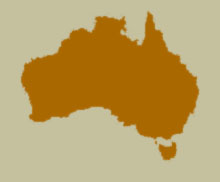Synonyms
Bucolus idyleae Slipinski and Dolambi, 2007:770.
Diagnosis
Smaller specimens of B. idyleae are easily mistaken for B. frater but can be distinguished from that species by the complete abdominal postcoxal line and notched external edge of the protibia at level of tarsal groove.
Description
Length 3.2-4.7 mm. Colour dark brown to black, mouthparts, antennae, apices of tibiae and tarsi and abdomen orange, remaining part of ventral side dark brown. Dorsum weakly to moderately convex, covered with dense, whitish pubescence forming distinct whorled pattern on elytra. Punctures on head about as large as eye facets, separated by 1.5-2.5 diameters; intervals between punctures shiny without microsculpture. Anterior clypeal margin almost straight. Antenna as in Fig. 88. Apical maxillary palpomere, as long as broad and weakly expanded. Eyes slightly emarginate; at frons separated by about 2 times eye width. Pronotal base not margined; prosternum long in front of procoxae with distinct and forward oriented, sparsely setose projection that is about 0.5 times as broad as prosternum. Prosternal process 0.6-0.7 times as wide as transverse coxal diameter. Hypomeron concave but without distinct foveae. Scutellum triangular, setose. Elytral surface densely, irregularly punctate; setigerous punctures as large as pronotal ones of variable dispersion; interspaces shiny and without noticeable microsculpture. Epipleuron strongly narrowing posteriorly from the level of abdomen and completely absent apically. Foveae well defined; the mesofemoral fovea delimited both on metepisternum and epipleuron; the metafemoral one deeply delimited on epipleuron. Meso-metaventral junction about as wide as mesocoxa; mesoventrite arcuate and bordered anteriorly. Protibia short and broad with deep notch along external margin of tarsal groove; mid and hind tibiae similar, broad and sharply angulate externally; claws in both sexes appendiculate with basal tooth prominent and short, in male almost as long as claw. Abdominal postcoxal line recurved and incomplete; ventrite V truncate with fine marginal line.
Male
UNDER CONSTRUCTION
Female
UNDER CONSTRUCTION
Variation
UNDER CONSTRUCTION
 Distribution and Biology
Distribution and Biology
This species is widely distributed in Tasmania, Victoria, NSW and southern Queensland.
Species References
Slipinski, A and Dolambi, F. 2007. Revision of the Australian Coccinellidae (Coleoptera). Part 7. Genus Bucolus Mulsant. Annales Zoologici (Warszawa), 57: 763-781.
[ Top ]
